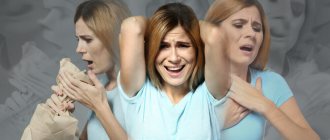Prevention of stress, diagnosis of stress, Sleep Irina Vasilyeva Surely everyone has experienced a similar feeling. You fall asleep and fall asleep and suddenly it begins to seem like you are falling. An unexpected fall does not last long. It ends with a sharp start and waking up. Or here's another example. You look at a sleeping person and see how his limbs tremble during sleep. And when he wakes up, this person cannot even remember what he dreamed about. What causes a person to startle or jerk violently in their sleep? Isn't this harmful? Or maybe this signals some kind of physiological or mental disorder? There are a lot of explanations for this phenomenon on the Internet: from scientific to esoteric. But which of them is true and which is false? Let's figure it out together.
Good afternoon, dear reader! Today we will look at all the possible causes of this condition.
Some of them will be characteristic of healthy people, others – not so healthy.
I think you can easily determine what belongs to the first and what to the second group.
Classification of startles when falling asleep in adults
Most often, myoclonus occurs for the simplest reasons. For example, after severe physical fatigue. That is, it is not a symptom of a serious illness. Night cramps, or myoclonus, are divided into several types based on the source of localization in the nervous system:
- Stem. They occur when nerve receptors are overexcited.
- Cortical. They are provoked by an external stimulus - sudden noise, bright light.
- Spinal. This type is most often a consequence of inflammatory diseases, heart attacks, tumors, and injuries.
- Peripheral. Consequence of damage to elements of the peripheral nervous system.
Factors that cause myoclonus attacks
In the presence of certain diseases of the body, the causes of myoclonic spasms when falling asleep or during sleep can be:
- Diffuse processes in the gray matter of the brain caused by a whole list of pathologies.
- Neurological diseases of various etiologies.
- Brain hypoxia, or oxygen starvation.
- Uremia. If the normal functioning of the kidneys is disrupted, the body is poisoned by the products of protein metabolism.
- Hyperosmolar coma.
Simpler causes of myoclonus in adults include:
- Excessive physical activity, especially close to bedtime.
- Stress, anxiety, prolonged nervous tension.
- Drinking coffee or energy drinks.
- Nutrient deficiency.
- Tobacco smoking.
Also, attacks of myoclonus occur due to taking certain medications.
Differential diagnosis
The cause of involuntary shuddering when falling asleep can only be determined by differential diagnosis. Modern equipment makes it possible to identify diseases with similar symptoms at an early stage. Only after a full examination, in some cases:
- CT or MRI;
- electroencephalography;
- radiography;
- Ultrasound of the vessels of the cervical spine and head;
- ECHO.
Treatment is prescribed individually.
Theories of involuntary movements
This question remains open. The most common reasons for such movements are given below.
Muscle relaxation
It is believed that during REM sleep, when a person can dream, his arm and leg muscles are paralyzed. But the brain continues to control the state of the body as a whole. For reasons that are still unclear, it happens that muscles relaxed during sleep are perceived by him as something wrong that requires intervention. The brain tries to change the state of the body, to wake it up. Limbs begin to twitch in sleep.
Stress
Also, the cause of involuntary twitching of the arms and legs, trembling of the body during sleep is considered to be a state of stress. Or just an uncomfortable body position on the bed. These conditions do not necessarily lead to the appearance of myoclonus. But the presence of these factors in people increases the likelihood of the syndrome occurring.
If a person tries to sleep after a noticeable nervous disorder, then sometimes the brain suddenly receives a danger signal, for example, the threat of a body falling. The signal is processed and the cause of the danger is sought. At this time, the person is in a state of half-asleep. And, as a rule, I dream about an unexpected fall. When a person wakes up, he usually remembers a dream in which he unexpectedly falls.
Restless legs syndrome
If involuntary and uncontrollable twitching of the limbs while falling asleep occurs regularly over a long period of time, you should consult a doctor. Since in this case, periodic limb movements syndrome may develop. It develops in different ways: in some people it manifests itself during the daytime, without bothering us at all at night.
The result of the development of SPD is a constant interruption of the deep sleep phase, but it does not lead to complete awakening. Therefore, a person does not realize that there is a problem, but the body cannot get proper rest during sleep. In turn, this leads to worsening nervous disorders.
Sleep apnea in adults
Periodic limb movements syndrome is very similar in its symptoms to another movement disorder, restless legs syndrome. These are different pathologies.
The main discomforts associated with restless legs syndrome:
- burning,
- tingling,
- numbness in the legs, including the feet.
Symptoms are relieved for a short time or disappear completely with any movement. Walking, squats, and bending will help remove unpleasant manifestations. The problem is that everything happens when a person is about to fall asleep. Consequently, the quality of sleep decreases. The body again cannot fully rest.
In Parkinson's disease, Huntington's disease, and apnea, involuntary movements of the limbs when falling asleep or during sleep are an almost constant symptom.
In themselves, such shudders or involuntary movements of the limbs do not cause harm. This is only a consequence of processes occurring in the peripheral nervous system, or existing pathologies
Types of spasms and twitching
At the moment of falling asleep, the body relaxes, and the brain classifies this fact as dangerous. A sharp muscle twitching becomes a triggering mechanism, a reaction to danger. Excessive muscle tension can also lead to involuntary winces. Convulsions during sleep are of various types:
- synchronous and asynchronous;
- rhythmic and arrhythmic;
- spontaneous;
- reflex.
Experts classify involuntary muscle spasms as
- myoclonic jerks;
- hypnogogic convulsions;
- restless legs syndrome;
- sleep paralysis
Let's figure out what is unique about each type. Is the “shudder and wake up” state dangerous for the body?
Myoclonic jerks
Irregular twitching that does not have a constant location is characteristic of people suffering from epilepsy. It often occurs in older people and is associated
- with neuroses;
- decreased amount of oxygen in muscle tissues;
- age-related degenerative changes occurring in cells.
Muscle contractions can occur in individual parts of the body (legs or arms, facial muscle contractions are possible) or cover it completely. The location of seizures often changes. The danger of myoclonic twitches lies in their ability to progress.
Involuntary muscle contractions (myoclonus) can occur not only at rest, but also during movement.
Hypnogic seizures
This type of involuntary movement, when the legs move when falling asleep, is still being studied. Experts have not come to a definite conclusion about the cause of their occurrence. According to the results of recent studies, it was discovered that involuntary spasms occur when the cervical vertebrae relax at the moment of falling asleep. The nerve fibers leading to the muscles simultaneously become excited, and the person feels a sharp spasm, leading to awakening.
Restless legs syndrome
The phenomenon is typical for middle-aged and elderly people and has a precise location. Unlike previous varieties, the cause of the movements produced is an unpleasant sensation that occurs in the lower extremities: burning, pain. To relieve the feeling of discomfort, a person begins to make involuntary movements with his legs. The disease can progress, and as a result, movements begin to be made with the hands. The syndrome occurs either as a result of acquired health problems or at the genetic level.
Sleep paralysis
This disease phenomenon is distinguished by the fact that the body does not produce sudden shudders, but on the contrary, the person does not have the ability to make them. The brain realizes the need to perform certain movements when waking up, but the body refuses to obey the ongoing impulses. Sleep paralysis does not cause a sudden awakening. Attacks occur only upon normal awakening after sleeping on your back. Doctors believe that stress and an inactive lifestyle are prerequisites for the appearance of sudden numbness.
Did you know that in medieval Europe people were subjected to the Inquisition due to sleep paralysis?
Restoration of motor function will occur when the brain is fully involved in work and is aware of what is happening. At this stage, you can begin to slowly move your tongue, eyes, limbs, starting with your fingers. Having managed to raise your head, you can try more active movements.
Other causes of twitching during sleep
The human brain never completely switches off during life. At night it works, but with less intensity. Monitoring of the condition of all organs and processes continues.
Sometimes the slightest muscle contraction is recognized by the brain as a danger signal, and the response signal is aimed at changing the situation. As a result, a person sleeps without waking up at all, but, for example, turns over and changes his position in his sleep. The most common reasons for shuddering in sleep are given below.
Slow breathing
The cause of involuntary movements of the upper body can be a violation of the breathing rhythm. Too few breaths and low levels of air flow create oxygen starvation in the brain. In response, he tries to wake up the body, make the lungs work more intensely.
Intense physical activity during the day
During intense physical activity, lactic acid accumulates in the muscles. It excessively increases muscle tone, resulting in chaotic contractions. Involuntary motor activity at night is manifested by those parts of the body that experienced the greatest load during the day. The person jerks his legs or his whole body.
Mental stress
Often the brain, having received a large amount of complex or negative information during the day, continues to process it at night. But at the same time he will work with greater intensity than usual. This will greatly interfere with falling asleep normally, the person will twitch. All kinds of deadlines and time pressures are fraught with insomnia.
Physiological feedback
The involuntary movements that occur for this reason are almost unnoticed by a person. They do not interrupt the deep sleep phase and do not lead to complete awakening at night. This is a normal process by which the brain controls the state of the entire body during the night's rest. The brain sends signals to the organs and receives a response, while the movements are weak and reflexive.
External stimuli
Normal sleep is possible in silence and darkness. Bright light and sharp sounds provoke the body's sensory systems to send signals of danger to the brain. Therefore, the brain tries to wake up the body.
Circulatory disorders
Night twitching may be caused by poor blood circulation. It occurs as a result of an uncomfortable posture. The second option is the presence of any pathologies. Then involuntary movements during sleep help to increase blood flow and the unpleasant sensations stop.
Preventing flinches
If falling during dreams and night tremors are not a disorder caused by a malfunction of the body's systems, then the provoking factor is emotional, mental or physical stress. In this case, for a restful sleep, you need to relax and tone your muscles. To do this you need:
- listen to calm melodies;
- take a relaxing bath;
- drink tea with soothing herbs;
- If possible, go for a massage.
INTERESTING FACTS!
- Scientists at the British Academy of Sound Therapy have named Marconi Union's Weightless the most relaxing song on Earth. Doctors and scientists have tried to figure out what melodies and rhythms contribute to complete relaxation.
- When listening to this music, blood pressure decreases, the concentration of stress noise and brain activity decreases. The pulse slows down by 35%, the level of anxiety drops by 65%, and a feeling of floating in weightlessness appears.
- The sounds of the melody help you fall asleep, so the annotation to the composition says that it is prohibited to listen to while driving.
USEFUL INFORMATION: Why people talk in their sleep: reasons
If you wake up with a start, don't be alarmed or panic. Try to relax your whole body by focusing on the tips of your toes, imagining that they are getting warmer, and gradually moving this sensation to your legs, stomach, chest, arms, and facial muscles. This will most likely help you fall asleep peacefully.
Night trembling is not always a consequence of the disease. With a properly organized work day, carefully calculated physical activity and moderate evening meals, you can get rid of them once and for all.
Why does a sleeping baby twitch?
If your child's twitches during sleep are repeated frequently and interfere with normal sleep, this is a reason to visit a pediatrician. Good sleep is even more important in infancy than in adulthood. To begin with, parents should observe the child to rule out any everyday causes for such manifestations.
In children, twitching of limbs during sleep occurs very often. There are also ordinary physiological reasons for this, natural for age. But there is also the possibility of developing the disease
In most cases there is no cause for alarm. This is a normal physiological process of a baby getting used to the world around him, to conditions that are radically different from those in which he developed for nine months.
Another reason is that the baby's nervous system is not yet fully developed. The braking mechanisms are not yet fully operational. The transition from the waking state to the sleep state has some difficulties. There are other reasons:
- In premature babies, twitching during sleep occurs more often in the first months of life.
- Very active children have difficulty falling asleep. It is more difficult for their nervous system to calm down.
- If your baby's sleep-wake schedule is disrupted, he becomes overtired and takes much longer to fall asleep.
- The result of dreams. Science recognizes that a child can dream even during the period of intrauterine development. The baby also dreams and may startle from this. Nothing wrong with that.
- Hypnagogic myoclonus. It appears not only in children (usually between 4 and 7 years old), but also in adults. As a result of dreams, in which a sleeping person seems to be falling somewhere or suddenly failing, sharp spontaneous contractions of individual groups of muscle fibers occur. Sometimes this is accompanied by increased heart rate and breathing. After waking up, unpleasant symptoms and feelings of anxiety pass very quickly, without causing harm to the body.
- Pain syndrome. At first, after starting complementary feeding, babies experience colic. This is a normal symptom of the digestive system getting used to a different type of food.
- The newborn often jerks his arms and legs at a very high temperature.
The process of teething is constantly accompanied by pain. This also leads to involuntary twitching during sleep.
Dangerous causes of baby twitching
Myoclonic spasms in childhood may indicate significant disorders in the body:
- Changes in metabolism. Low or high blood glucose levels. Glucose deficiency often provokes seizures.
- Encephalopathy. Brain damage in newborns during labor. Pathology can also be congenital.
- Meningitis. Inflammatory process of the membranes of the brain. Pathology is caused by infections.
- Encephalitis. Infectious disease of the brain.
- Epilepsy. Pathology of the brain, accompanied by frequent spontaneous seizures.
Twitching during sleep causes the baby to wake up
Treatment
It is worth noting that all medications must be taken after diagnosis and identification of the origin of involuntary muscle contractions.
Drug treatment is prescribed only by the attending physician, since there can be many causes of the syndrome.
Anticonvulsants from the Anticonvulsants group occupy the main place in the fight against spasms.
Among the medicines, antiepileptic drugs have proven themselves:
- Barbiturate;
- Clonazepam;
- Volproate;
- Benzodiazapine;
- bioactive supplement L-tryptophan;
- Tryptophan.
How to get rid of myoclonic spasms
In the absence of neurological diseases, the recommendations are simple. Significant physical activity should be completed 3-4 hours before bedtime. Stress should be avoided whenever possible. If you still feel nervous during the day, it is better to take a light sedative in advance.
It is better to take your last meal at least 2 hours before going to bed. The place to sleep should be comfortable. If necessary, it is worth replacing the pillow or mattress or even rearranging the bed for a comfortable night's sleep.










